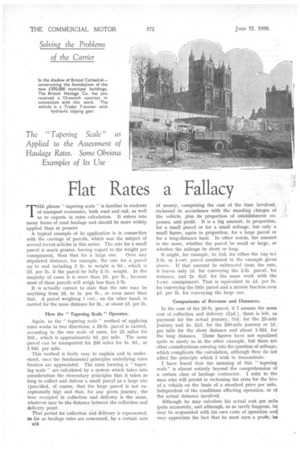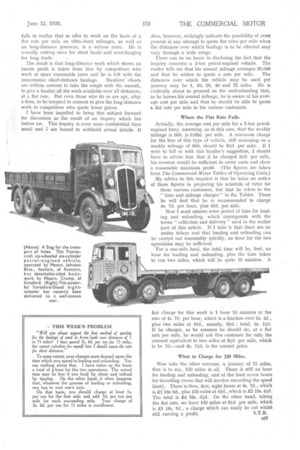Flat Rates a Fallacy
Page 44

Page 45

If you've noticed an error in this article please click here to report it so we can fix it.
THE phrase " tapering scale "is familiar to students of transport economics, both road and rail, as well as to experts in rates calculation. It enters into many forms of road haulage and should be more widely applied than at present.
A typical example of its application is in connection with the carriage of parcels, which was the subject of several recent articles in this series. The rate for a small parcel is much greater, having regard to the weight per consignment, than that for a large one. Over any stipulated distance, for example, the rate for a parcel up to and including 3 lb. in weight is 6d., which is 2d. per lb. if the parcel be fully 3 lb. weight. In the majority of cases it is more than 2d. per lb., because most of these parcels will weigh less than 3 lb.
It is actually correct to state that the rate may be anything from 2d. to is. per lb., or even more than that. A parcel weighing 1 cwt., on the other hand, is carried for the same distance for 3s., or about id. per lb.
How the " Tapering Scale" Operates.
Again, as the "tapering scale" method of applying rates works in two directions, a 28-lb. parcel is carried, according to the one scale of rates, for 25 miles for 10d., which is approximately id. per mile. The same parcel can be transported for 200 miles for is. 8d., or 1-10d. per mile.
This method is fairly easy to explain and to understand, once the fundamental principles underlying rates fixation are appreciated. The rates forming a " tapering scale" are calculated by a system which takes into consideration the elementary principles that it takes as long to collect and deliver a small parcel as a large one (provided, of course, that the large parcel is not exceptionally big) and that, for any given journey, the time occupied in collection and delivery is the same, whatever may be the distance between the collection and delivery point.
That period for collection and delivery is represented, so far as haulage rates are concerned, by a certain sum 326
of money, comprising the cost of the time involved, reckoned in accordance with the standing charges of the vehicle, plus its proportion of establishment expenses, and profit. It is a big amount, in proportion, for a small parcel or for a small mileage, but only a small figure, again in proportion, for a large parcel or for a long-distance haul. In other words, the amount is the same, whether the parcel be small or large, or whether the mileage be short or long.
It might, for example, be 51d. for either the (up to) 3-lb. or 1-cwt. parcel mentioned in the example given above. If that amount be subtracted from the rate, it leaves only Id. for conveying the 2-lb. parcel, for instance, and 2s. 61d. for the same work with the 1-cwt. consignment. That is equivalent to Id. per lb. for conveying the little parcel and a minute fraction ovei Id. per lb. for conveying the large one.
Comparisons of Revenue and Distances.
In the case of the 28-lb. parcel, if I assume the same cost of collection and delivery (51d.), there is left, as payment for the actual journey, 54d. for the 25-mile journey and is, 21d. for the 200-mile journey or 1d. per mile for the short distance and about 1-13d. for the long distance. These figures have not equalized' quite so nicely as in the other example, but there are other considerations entering into the question of mileage; which complicate the calculation, although they do not affect the principle which I wish to demonstrate.
I have found that the meaning of this "tapering scale" is almost entirely beyond the comprehension of a certain class of haulage contractor. I refer to the man who will persist in reckoning his rates for the hire of a vehicle on the basis of a standard price per mile, independent of the conditions affecting operation, or of the actual distance involved.
Although he may calculate his actual cost per mile quite accurately, and although, as so rarely happens, ho may be acquainted with his own costs of operation and may appreciate the fact that he must earn a profit, hie fails to realize that to offer to work on the basis of a flat rate per mile on ultra-short mileages, as well as on long-distance journeys, is a serious error. He is actually cutting rates for short hapls and overcharging for long leads.
The result is that long-distance work which shows an excess profit is taken from him by cotaipetiters who work at more reasonable rates and he is left with the uneconomic short-distance haulage. Hauliers' clients are seldom content to take the rough with the smooth, to give a haulier all the work available over all distances, at a flat rate. But even those who do so are apt, after a time, to be tempted to consent to give the long-distance work to competitors who quote lower prices.
I have been impelled to bring this subject forward for discussion as the result of an inquiry which lies before me. This inquiry is even more confidential than usual and I am bound to withhold actual details. It
does, however, strikingly indicate the possibility of error present in any attempt to quote fiat rates per mile when the distances over which haulage is to be effected may vary through a wide range.
There can be no harm in disclosing the fact that the inquiry concerns a 5-ton petrol-engined vehicle. The reader tells me that his annual mileage averages 30,000 and that he wishes to quote a rate per mile. The distances over which the vehicle may be used per journey may be 1, 10,20, 40 and 75 miles. He is evidently about to proceed on the understanding that, as he knows his annual mileage, he is aware of his average cost per mile and that he should be able to quote a flat rate per mile to his various customers.
Where the Flat Rate Fails.
Actually, the average cost per mile for a 5-ton petrolengined lorry, assuming, as in this case, that the weekly mileage is 600, is 6.93d, per mile. A minimum charge for the hire of this type of vehicle, still reckoning on a weekly mileage of 600, should be Did. per mile. If I were to fall in with this haulier's suggestion, I should have to advise him that if he charged 9id. per mile, his revenue would be sufficient to cover costs and show a reasonable minimum profit. (The figures are taken from The Commercial Motor Tables of Operating Costs.)
My advice to this inquirer is that he takes no notice of those figures in preparing his schedule of rates for these various customers, but that he refers to the "lime and mileage charges" in the Tables. There he will find that he is recommended. to charge 4s. 7d. per hour, plus 4id. per mile.
Now I must assume some period of time for loading and unloading, which corresponds with the terms " collection and delivery" Used in the earlier part of this article. If I take it that there are no undue delays and that loading and unloading can be carried out reasonably quickly, an hour for the two operations may be sufficient.
For a one-mile haul, the total time will be, first, an hour for loading and unloading, plus the time taken to run two miles, which will be quite 10 minutes. A fair charge for this work is 1 hour 10 minutes at the rate of 4s. 7d. per hour, which is a fraction over 5s. 4d., plus two miles at Od., namely, 9d.: total, 6s. lid. If he charges, as he assumes he should do, at a flat rate per mile, he would ask this customer for only the amount equivalent to two miles at 94d. per mile, which is is. 7d.—and 6s. lid. is the correct price.
What to Charge for 150 Miles.
Now take the other extreme, a journey of 75 miles, that is to say, 150 miles in all. There is still an hour for loading and unloading, and at the least seven hours for travelling (even that will involve exceeding the speed limit). There is then, first, eight hours at 4s. 7d., which is 16s. 8d., plus 150 miles at 4d., which is £2 19s. 44d. The total is £4 16s. Old. On the other hand, taking the flat rate, we have 150 miles at .9d. per 'mile, which is £5 18s. 9d., a charge which can easily be cut whilst still earning a profit. S.T.R.




































































































